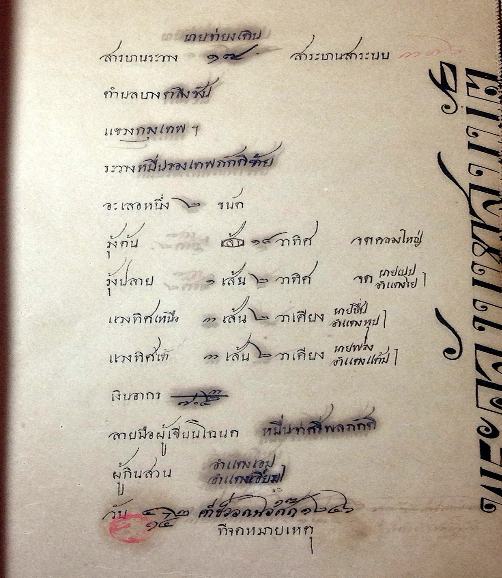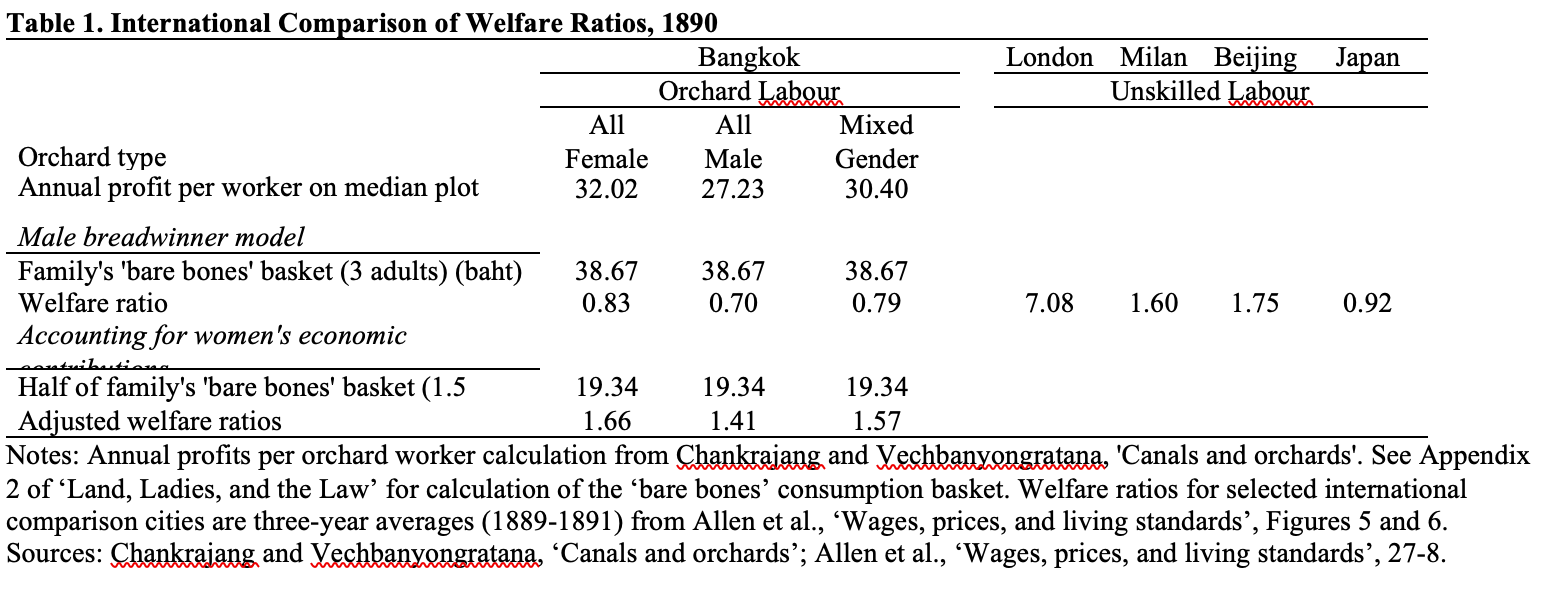Land, Ladies, and the Law: A Case Study on Women’s Land Rights and Welfare in Southeast Asia in the Nineteenth Century
by Thanyaporn Chankrajang and Jessica Vechbanyongratana (Chulalongkorn University)
The full article from this blog is forthcoming on The Economic History Review
Security of land rights empowers women with greater decision-making power (Doss, 2013), potentially impacting both land-related investment decisions and the allocation of goods within the households (Allendorf, 2007; Goldstein et al., 2008; Menon et al., 2017). In historical contexts where land was the main factor of production for most economic activities, little is known about women’s land entitlements. Historical gender-disaggregated land ownership data are scarce, making quantitative investigations of the past challenging. In new research we overcome this problem by analyzing rare, gender-disaggregated, historical land rights records to determine the extent of women’s land rights, and its implications, in nineteenth-century Bangkok.
First, we utilized orchard land deeds issued in Bangkok during the 1880s (Figure 1). These deeds were both landownership and tax documents. Land tax assessment was assessed based on the enumeration of mature orchard trees producing high-value fruits, such as areca nuts, mangoes and durian. From 9,018 surviving orchard deeds, we find that 82 per cent of Bangkok orchards listed at least one woman as an owner, indicating that women did possess de jure usufruct land rights under the traditional land rights system. By analyzing the number of trees cultivated on each property (proxied by tax per hectare), we find these rights were upheld in practice and incentivized agricultural productivity. Controlling for owner and plot characteristics, plots with only female owners on average cultivated 6.7 per cent more trees per hectare than plots with mixed gender ownership, while male-owned plots cultivated 6.7 per cent fewer trees per hectare than mixed gender plots. The evidence indicates higher levels of investment in cash crop cultivation among female landowners.

The second part of our analysis assesses 217 land-related court cases to determine whether women’s land rights in Bangkok were protected from the late nineteenth century when land disputes increased. We find that ‘commoner’ women acted as both plaintiffs and defendants, and were able to win cases even against politically powerful men. Such secure land rights helped preserve women’s livelihoods.
Finally, based on an internationally comparable welfare estimation (Allen et al. 2011; Cha, 2015), we calculate an equivalent measure of a ‘bare bones’ consumption basket. We find that the median woman-owned orchard could annually support up to 10 adults. By recognizing women’s contributions to family income (Table 1), Bangkok’s welfare ratio was as high as 1.66 for the median household, demonstrating a larger household surplus than found in Japan, and comparable to those in Beijing and Milan during the same period (Allen et al. 2011).
Superficially, our findings seem to contradict historical and contemporary observations that land rights structures favor men (Doepke et al., 2012). However, our study typifies women’s economic empowerment in Thailand and Southeast Asia more generally. Since at least the early modern period, women in Southeast Asia possessed relatively high social status and autonomy in marriage and family, literacy and literature, diplomacy and politics, and economic activities ( Hirschman, 2017; Adulyapichet, 2001; Baker et al., 2017). The evidence we provide supports the latter interpretation, and is consonant with other Southeast Asian land-related features, such as matrilocality and matrilineage (Huntrakul, 2003).

To contact the authors:
Thanyaporn Chankrajang, Thanyaporn.C@chula.ac.th
Jessica Vechbanyongratana, ajarn.jessica@gmail.com
@j_vechbany
References
Adulyapichet, A., ‘Status and roles of Siamese women and men in the past: a case study from Khun Chang Khun Phan’ (thesis, Silpakorn Univ., 2001).
Allen, R. C., Bassino, J. P., Ma, D., Moll‐Murata, C., and Van Zanden, J. L. ‘Wages, prices, and living standards in China, 1738–1925: in comparison with Europe, Japan, and India’, Economic History Review, 64 (2011), pp. 8-38.
Allendorf, K., ‘Do women’s land rights promote empowerment and child health in Nepal?’, World development, 35 (2007), pp. 1975-88.
Baker, C., and Phongpaichit, P., A history of Ayutthaya: Siam in the early modern world (Cambridge, 2017).
Cha, M. S. ‘Unskilled wage gaps within the Japanese Empire’, Economic History Review, 68 (2015), pp. 23-47.
Chankrajang, T. and Vechbanyongratana, J. ‘Canals and orchards: the impact of transport network access on agricultural productivity in nineteenth-century Bangkok’, Journal of Economic History, forthcoming.
Chankrajang, T. and Vechbanyongratana, J. ‘Land, ladies, and the law: a case study on women’s land rights and welfare in Southeast Asia in the nineteenth century’, Economic History Review, forthcoming.
Doepke, M., Tertilt, M., and Voena, A., ‘The economics and politics of women’s rights’, Annual Review of Economics, 4 (2012), pp. 339-72.
Doss, C., ‘Intrahousehold bargaining and resource allocation in developing countries’, World Bank Research Observer 28 (2013), pp.52-78.
Goldstein, M., and Udry, C., ‘The profits of power land rights and agricultural investment in Ghana’, Journal of Political Economy, 116 (2008), pp. 981-1022.
Hirschman, C. ‘Gender, the status of women, and family structure in Malaysia’, Malaysian Journal of Economic Studies 53 (2017), pp. 33-50.
Huntrakul, P., ‘Thai women in the three seals code: from matriarchy to subordination’, Journal of Letters, 32 (2003), pp. 246-99.
Menon, N., van der Meulen Rodgers, Y., and Kennedy, A. R., ‘Land reform and welfare in Vietnam: why gender of the land‐rights holder matters’, Journal of International Development, 29 (2017), pp. 454-72.

